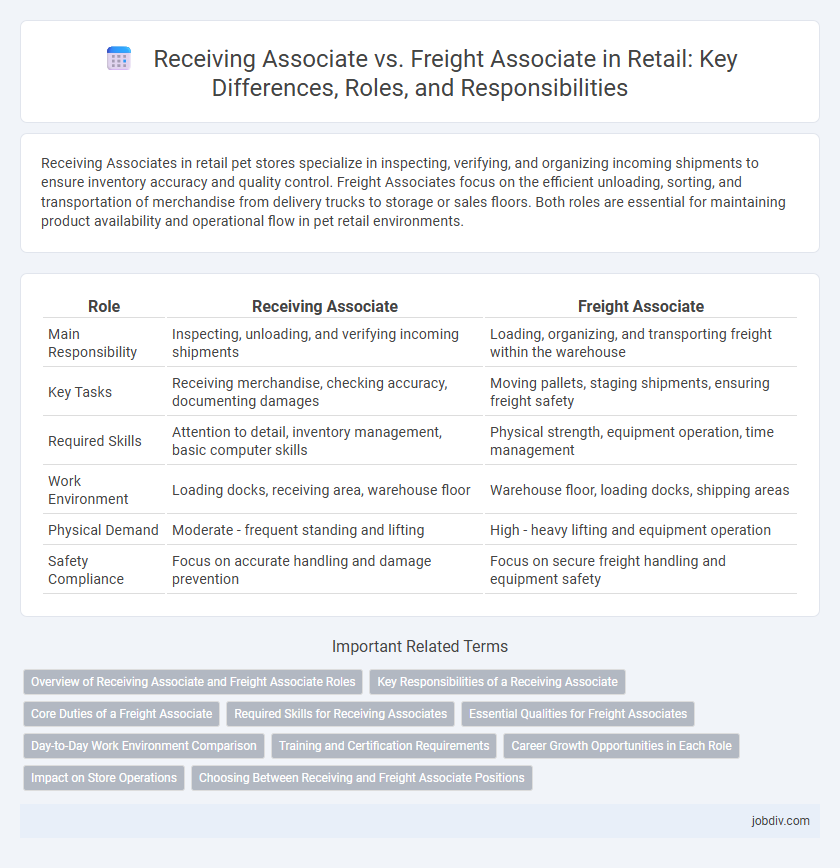Receiving Associates in retail pet stores specialize in inspecting, verifying, and organizing incoming shipments to ensure inventory accuracy and quality control. Freight Associates focus on the efficient unloading, sorting, and transportation of merchandise from delivery trucks to storage or sales floors. Both roles are essential for maintaining product availability and operational flow in pet retail environments.
Table of Comparison
| Role | Receiving Associate | Freight Associate |
|---|---|---|
| Main Responsibility | Inspecting, unloading, and verifying incoming shipments | Loading, organizing, and transporting freight within the warehouse |
| Key Tasks | Receiving merchandise, checking accuracy, documenting damages | Moving pallets, staging shipments, ensuring freight safety |
| Required Skills | Attention to detail, inventory management, basic computer skills | Physical strength, equipment operation, time management |
| Work Environment | Loading docks, receiving area, warehouse floor | Warehouse floor, loading docks, shipping areas |
| Physical Demand | Moderate - frequent standing and lifting | High - heavy lifting and equipment operation |
| Safety Compliance | Focus on accurate handling and damage prevention | Focus on secure freight handling and equipment safety |
Overview of Receiving Associate and Freight Associate Roles
Receiving Associates are responsible for inspecting, verifying, and processing incoming shipments to ensure accuracy and quality compliance, playing a crucial role in inventory management. Freight Associates focus on loading, unloading, and transporting goods within warehouses or retail locations, emphasizing the efficient handling and movement of products. Both roles require attention to detail and physical stamina, supporting seamless supply chain operations in retail environments.
Key Responsibilities of a Receiving Associate
A Receiving Associate is responsible for accurately inspecting and verifying incoming shipments, ensuring all products meet quality standards and match purchase orders. They efficiently unload, sort, and organize merchandise in the inventory system to maintain optimal stock levels. Unlike Freight Associates who focus on loading and transporting goods, Receiving Associates prioritize inventory accuracy and data entry to support seamless supply chain operations.
Core Duties of a Freight Associate
A Freight Associate is primarily responsible for unloading, sorting, and organizing incoming shipments to ensure efficient inventory management within retail warehouses. Their core duties include inspecting freight for damage, verifying shipment accuracy against manifests, and preparing goods for storage or distribution. This role demands strong knowledge of logistics processes, proficiency in operating material handling equipment, and adherence to safety protocols to maintain workflow efficiency.
Required Skills for Receiving Associates
Receiving Associates require strong organizational skills, attention to detail, and proficiency in inventory management systems to accurately process incoming shipments. They must demonstrate effective communication abilities to coordinate with suppliers and other departments, as well as physical stamina for handling and inspecting merchandise. Unlike Freight Associates who primarily focus on loading and unloading freight, Receiving Associates ensure proper documentation and quality control during the intake process in retail environments.
Essential Qualities for Freight Associates
Freight Associates excel in physical stamina, attention to detail, and efficiency in handling inventory movement within retail environments. Mastery of safety protocols and proficiency in operating material handling equipment are critical to prevent damage and ensure timely deliveries. Strong communication skills and teamwork facilitate seamless coordination with receiving departments, optimizing supply chain workflows.
Day-to-Day Work Environment Comparison
Receiving Associates typically manage incoming shipments by verifying inventory accuracy, organizing stock in designated areas, and preparing goods for sales floors in a fast-paced retail environment. Freight Associates handle the unloading, sorting, and staging of merchandise from delivery trucks, often working in warehouse settings with heavy lifting and equipment operation responsibilities. Both roles require attention to detail and physical stamina but differ in workflow focus, with Receiving Associates emphasizing inventory control and Freight Associates prioritizing bulk merchandise handling.
Training and Certification Requirements
Receiving Associates require training in inventory management systems, safety protocols, and quality control standards, often supported by certifications such as OSHA Forklift Operation. Freight Associates focus on logistics, hazardous materials handling, and freight documentation, frequently needing certifications like HAZMAT and DOT Shipping. Both roles benefit from ongoing training in warehouse software systems and compliance to enhance operational efficiency and safety.
Career Growth Opportunities in Each Role
Receiving Associates typically gain expertise in inventory management and quality control, providing a strong foundation for advancement into supervisory or logistics coordinator roles. Freight Associates develop specialized skills in freight handling and warehouse operations, positioning themselves for career growth in supply chain management or warehouse supervision. Both roles offer distinct pathways to leadership positions within retail distribution and logistics departments.
Impact on Store Operations
Receiving Associates ensure accurate and timely processing of incoming shipments, directly impacting inventory accuracy and product availability on sales floors. Freight Associates manage the efficient unloading and movement of goods from delivery trucks to storage or sales areas, affecting the speed at which products reach shelves. Their coordinated efforts optimize store operations by minimizing stock discrepancies and enhancing customer satisfaction through consistent product accessibility.
Choosing Between Receiving and Freight Associate Positions
Choosing between Receiving Associate and Freight Associate positions depends on specific operational roles within retail supply chains. Receiving Associates focus on inspecting, documenting, and organizing incoming shipments to ensure accuracy and quality control. Freight Associates specialize in transporting, loading, and unloading goods efficiently, requiring physical strength and coordination to maintain timely inventory flow.
Receiving Associate vs Freight Associate Infographic

 jobdiv.com
jobdiv.com